
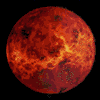
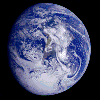
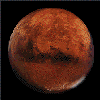
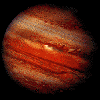



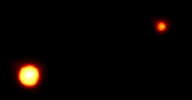
The Classic Pneumonic!
| Mercury | Venus | Earth | Mars | Jupiter | Saturn | Uranus | Neptune | Pluto |
| My | Very | Educated | Mother | Just | Served | Us | Nine | Pickels |









Rough Size Scale :
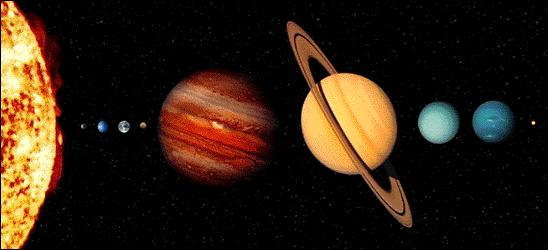
Info Chart for the Planets :
| Categories | Mercury | Venus | Earth | Moon | Mars | Jupiter | Saturn | Uranus | Neptune | Pluto |
| Mean Distance (AU) | 0.387 | 0.723 | 1.0 | 384,400 km
~30 E-Diam |
1.523 | 5.203 | 9.555 | 19.218 | 30.110 | 39.341 |
| Period of Revolution | 88 days | 224.7 days | 365.3 days | 27.3 days | 687 days | 11.86 yrs | 29.46 yrs | 84 yrs | 165 yrs | 248 yrs |
| Equitorial Diameter (km) | 4,880 | 12,100 | 12,756 | 3,476
~1/4 E-Diam |
6,794 | 143,200 | 120,000 | 51,800 | 49,528 | ~2,330 |
| Atmosphere Components | Almost none | Carbon
Dioxide |
Nitrogen
Oxygen |
Almost none |
Carbon
Dioxide |
Hydrogen
Helium |
Hydrogen
Helium |
Helium
Hydrogen Methane |
Hydrogen
Helium Methane |
Methane
+? |
| Moons | 0 | 0 | 1 | 0 | 2 | 16 | 18 | 15 | 8 | 1 |
| Rings | 0 | 0 | 0 | 0 | 0 | 3 | 1,000 (?) | 11 | 4 | 0 |
| Inclination of orbit to ecliptic | 7 deg | 3.4 deg | 0 deg | 5.2 deg | 1.9 deg | 1.3 deg | 2.5 deg | 0.8 deg | 1.8 deg | 17.1 deg |
| Eccentricity of the Orbit | 0.206 | 0.007 | 0.017 | 0.055 | 0.093 | 0.048 | 0.056 | 0.046 | 0.009 | 0.248 |
| Rotation Period | 59 days | 243 days | 23 hrs 56 min | 27.3 days | 24 hrs 31 min | 9 hrs 55 min | 10 hrs 40 min | 17.2 hrs | 16 hours | 6 days 9 hours |
| Inclination of axis * | near 0 | 177.2 deg | 23.45 deg | 6.68 deg | 25.2 deg | 3.08 deg | 26.73 deg | 97.92 deg | 28.8 deg | 120 deg |
If the axis is inclined more than 90 degrees, the planet is more "upside down", and thus rotates around retrograde compared to its orbit.
Chart info taken from an Nasa graphic.
The BIGGEST Solar System objects :
Distance Radius Mass
Name Orbits (000 km) (km) (kg)
--------- ------- -------- ------- -------
Sun 697000 1.99e30
Jupiter Sun 778000 71492 1.90e27
Saturn Sun 1429000 60268 5.69e26
Uranus Sun 2870990 25559 8.69e25
Neptune Sun 4504300 24764 1.02e26
Earth Sun 149600 6378 5.98e24
Venus Sun 108200 6052 4.87e24
Mars Sun 227940 3398 6.42e23
The Smallest Moons in the Solar System:
There are 13 moons whose radius is less than 20 km:
Distance Radius Mass
Name Orbits (000 km) (km) (kg)
--------- ------- -------- ------- -------
Deimos Mars 23 6 1.80e15
Leda Jupiter 11094 8 5.68e15
Adrastea Jupiter 129 10 1.91e16 *
Pan Saturn 134 10 ?
Phobos Mars 9 11 1.08e16 *
Calypso Saturn 295 13 ?
Cordelia Uranus 50 13 ?
The Brightest objects in the Solar System:
There are 12 major bodies brighter than magnitude 6 (as viewed from Earth). All of these can be seen with the unaided eye or with binoculars. The more negative the magnitude number, the brighter the object. For comparison .. Big Dipper stars are about +2 to +4 in magnitude.
Distance Radius
Name Orbits (000 km) (km) Vo
--------- ------- -------- ------- ---
Sun ? 0 697000 -26.8
Moon Earth 384 1738 -12.7
Venus Sun 108200 6052 -4.4
Jupiter Sun 778000 71492 -2.7
Mars Sun 227940 3398 -2.0
Mercury Sun 57910 2439 -1.9
Saturn Sun 1429000 60268 0.7
Ganymede Jupiter 1070 2631 4.6
Io Jupiter 422 1815 5.0
Europa Jupiter 671 1569 5.3
Uranus Sun 2870990 25559 5.5
Callisto Jupiter 1883 2400 5.6
Weight on the other planets? See this Exploratorium link
Chronology of Solar System Discovery
Prior to 1600 From the dawn of history until the
beginning of the 17th century the known universe consisted of only 8
bodies:
Earth, Sun, Moon, Mercury, Venus, Mars, Jupiter, Saturn plus
the "fixed" stars. In Europe, the prevailing view was the Ptolemaic
system with the Earth at the center and the other bodies revolving around
it.
The 17th Century In 1610 Galileo first turned a telescope on the heavens and the universe exploded. By the end of the 17th century, 9 new bodies had been discovered and Copernicus's heliocentric theory was widely accepted. The total number of known bodies had more than doubled to 17: Callisto, Europa, Ganymede, Io, Titan, Iapetus, Rhea, Dione, Tethys (these are mostly the moons of Jupiter and Saturn).
The 18th CenturyOnly 5 new bodies (not counting comets) were discovered in the 18th century (all by William Herschel) bringing the total to 22: Uranus, Oberon, Titania, Enceladus, Mimas.
The 19th CenturyThe number of bodies in the solar system increased dramatically in the 19th century with the discovery of the asteroids (464 of which were known at by 1899) but only 9 more "major" bodies were discovered. The number of major bodies rose to 31 (almost double the 17th century total). These included Neptune in 1846.
The 20th Century So far, in 20th century 40 more major bodies (and thousands of comets and asteroids) have been discovered (27 by the Voyager probes) more than doubling the count again to 73. Pluto was found in 1930 by Tombaugh, and its moon Charon in 1978 by Christy. Since Pluto has been discovered, it has not yet made an orbit of the Sun, thus we don't know its orbital parameters to a great deal of accuracy. (Neptune has not made a trip around either, but it will by about 2010, since we have so much of an orbit, we have some good "numbers" for Neptune.)